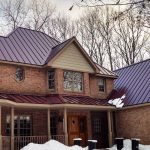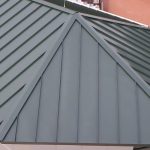
Your roof keeps your home in Grand Rapids comfortable and safe, keeping the weather out, and everything inside dry and protected. You may think that work like a new roof replacement is left for the spring and summer months.
However, leaving a roof that needs replacing until spring may leave you in a critical situation over the winter. Here’s how to know when it’s time for a new roof replacement, and why the fall is actually a great time to do so.
Knowing When You Need A New Roof
Before jumping to the idea you need a full roof replacement, look for the indications that it’s time. Start by checking your paperwork for the last time you had it replaced. Most asphalt shingle roofs last 20 to 25 years. If it’s nearing that age, it’s time to start planning for a new roof.
Look for signs of leaks, especially if you have an attic. Check for light filtering through your roof, water stains or streaks. From the outside, look to see if there’s any sagging, indicating bad roofing boards. Also look for shingles that have been damaged and are out of place.
Not all leaks or problems indicate you need a full roof replacement. It depends on the age of the roof, the degree of damage, and the cost to repair it. If you determine it’s time to put on a full replacement, here’s why fall is a great time to consider getting it done.
Ideal Weather for A Roof Replacement
Fall weather is generally pretty mild compared to the summer. This means you’re likely to experience fewer delays due to unexpected storms. It also means you won’t likely have safety concerns due to high wind or icy conditions. Roofers also work more efficiently when it’s more comfortable outside, and cooler temperatures provide that environment.
From a technical perspective, your shingles need an outside temperature of at least 45 degrees Fahrenheit. This allows the seal strip to melt and adhere properly, which is called thermal sealing. If you wait until the weather is colder, your job may be more complicated, needing to use heating guns to melt the seal strip.
Summer Storm Roof Damage
Summers around Clarksville bring with them storms, sometimes including damaging winds and tornados. By the end of the summer, your roof has taken the brunt of what mother nature has to offer, and may have suffered some damage.
You may notice this damage as shingles that have torn off, either entirely or partially. You may also notice some of your shingles starting to peel up and curl.
When you get a new roof replacement in the fall, you do it at a time when all of these damages are corrected before winter. If you have the work done earlier in the season, it may still be damaged by a storm, needing further work before winter.
Risk of Ice Damming
Older roofs are notorious for creating ice dams that wreak havoc on their integrity. You may recognize these dams as large icicles hanging from the eaves.
These form when snow collects on your shingles and then starts melting, usually do to poor ventilation or insufficient insulation. That water then runs down to the edge, where the temperature is cold enough to allow it to freeze again.
As the water slowly pushes back up from the edge, it’ll start freezing under the edge of loose shingles. If the problem is severe enough, it can cause the seal to break, and lead to a leak.
Any sagging creates more places where these dams may form. If they form away from the edge, it creates more opportunity for damage, leading to more substantial leaks and repairs. Making sure your roof is in good condition minimizes the risks of ice damming and their possible damage.
More Cost-Effective Roof Installation
If you need a new roof and you wait until there’s a major problem over the winter, you risk dramatically increasing your costs. As mentioned previously, shingles need an air temperature of at least 45 degrees to melt the seal strip. In addition to this, asphalt shingles tend to get brittle as the temperature gets colder.
While this may not be a major problem for properly installed shingles in good condition, it does pose a problem while trying to install them. The brittle shingles become more sensitive to the nails being driven in, causing them to crack or split when using nail guns. If the temperature is cold enough, it means replacing the faster installation with conventional hammers, driving up the price.
Reduce Winter Energy Bills
It’s no secret that your roof is one of the biggest energy losses in the winter, and why good insulation is important. However, if it’s not properly sealed, all the insulation in the world won’t contain the energy loss.
This is especially true if your HVAC unit is located in your attic. It will suck in the cold air as it runs, causing your system to work harder to get the air to the right temperature. Not only does this increase your energy bills directly, but also increases your HVAC strain, driving up repair costs. Simply installing a replacement helps prevent all of this by making sure it is properly sealed, protecting everything below it.
Get Roofing Contractors More Easily
Once the seasons turn, it’s more difficult to find contractors who are wiling to do the work. Many contractors consider the extra risks associated with roofing work over the winter. They also consider their cost with an installation in suboptimal temperatures.
You may find some companies who are wiling to offer a discount, being it’s the slow season. However, it may be difficult to find the laborers who have moved onto other kinds of work over the winter.
Don’t wait until you have snow falling inside your home to get the roof replacement you need. Call to schedule your consultation with the roofing experts at S&T Metals today.













